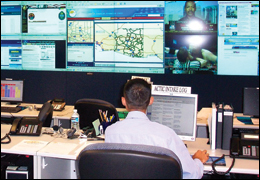Headline Archives |
|||||||||||||
| FUSION CENTERS Unifying Intelligence to Protect Americans |
|||||||||||||
| 03/12/09 | |||||||||||||
|
In Arizona, after determining the subjects of an international terrorism case were involved in local criminal activity, the case was referred to local law enforcement. In New Mexico, several individuals linked to FBI investigations—including an MS-13 gang member—were identified. In Tennessee, we developed—with our partners—a formal process for collecting, sharing, and analyzing suspicious activity reports, looking for trends and patterns. These cooperative efforts—and many more like them—have been made possible through the work of intelligence fusion centers around the country. These centers, usually set up by states or major urban areas and run by state or local authorities, are often supported by federal law enforcement, including the FBI.
Although a few were already in existence before 9/11, fusion centers really began to crop up after the attacks when local and federal officials recognized the need to quickly coordinate information-sharing related to terrorism. Their number has been growing ever since. Today, there are some 70 centers around the country—50 state and 20 regional. And some have expanded their focus to include public safety matters and major criminal threats. Fusion center personnel “fuse” intelligence from participating agencies to create a more comprehensive threat picture, locally and nationally. They don’t just collect information—they integrate new data into existing information, evaluate it to determine its worth, analyze it for links and trends, and disseminate their findings to the appropriate agency in the best position to do something about it.
Fusion Centers Joint Terrorism Task Forces FBI representation. We currently have 114 FBI employees working in 38 fusion centers—about 36 percent are agents, 61 percent are intelligence analysts, and the rest are in positions such as language and financial analysts. Fourteen of these centers are co-located with an FBI Field Intelligence Group or Joint Terrorism Task Force. Says Elaine Cummins, our Chief Information Sharing Officer, "Participating in a national network of fusion centers definitely helps us share timely, relevant, and actionable intelligence with our partners—an increasingly important component to our unique national security and law enforcement mission.” With fusion centers, everbody wins. State and local law enforcement agencies get access to certain federal databases and the benefit of big-picture terrorism and crime perspectives from their federal partners, along with grant funding, technical assistance, and training. Federal agencies like the FBI gain intelligence from the local level that may fuel terrorism or national security investigations elsewhere in the country or even overseas. And the public gets to sleep a little easier at night, knowing that their local, state, and federal officials are all working together to keep them safe. Resources: |
 |
 |
 |
|
|
|
|
||
|

